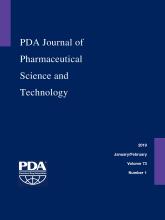Abstract
Compendia methods have historically been used to assess heavy metals in both drug products and packaging material extracts. However, these methods have been found to be inadequate for elemental specificity and accurate measurements. The International Council for Harmonization of Technical Requirements for Pharmaceuticals for Human Use (ICH) has published the Q3D, Guideline for Elemental Impurities, to provide a risk-based approach that specifies elements to be considered in a drug product risk assessment and permitted daily exposures (PDEs) depending on toxicological concern and route of administration. Consistent with these efforts, the United States Pharmacopeia (USP) withdrew the <231> Heavy Metals test procedure as of January 2018. The USP published new methods consistent with ICH Q3D risk-based approaches, <232> Elemental Impurities - Limits and <233> Elemental Impurities - Procedures. These new tests are intended for evaluation of drug products, leaving a gap in the assessment of extractable elements for packaging components. This gap prompted the need for a better understanding of the potential for elements of concern to extract from packaging materials and contribute to drug product elemental impurities. The present study investigated multiple extraction conditions coupled with modern analytical techniques to understand the capacity for elements to extract from elastomeric components. Most elements of interest, based on ICH or their potential for occurrence in elastomers, were ultimately recovered at levels below designated thresholds, allowing for correlation to PDE. These results highlight that although extractable elements from elastomeric components have the potential to contribute elemental impurities to a drug product, the actual contribution to cumulative levels would need to be calculated among all other potential sources as part of the process of elemental impurities assessment.
LAY ABSTRACT: Compendia methods have historically been used to assess heavy metals in final drug products and extracts from packaging materials. However, these methods were found to provide inadequate data to address the evolving risk concerns of elemental impurities in drug products and their potential toxic effects. The International Council for Harmonization of Technical Requirements for Pharmaceuticals for Human Use member countries are working toward implementing a risk-based approach that specifies elements to be considered in a drug product safety assessment and permitted daily exposures. The United States Pharmacopeia is coordinating with this goal by withdrawing the traditional procedure and replacing it with the tests that can inform safety risk assessments. However, the new tests are intended for evaluation of only final drug products, leaving a gap in the assessment of extractable elements for packaging components. The present study addressed this gap by focusing on elastomeric components used in injectable packaging systems and exploring appropriate elastomeric extraction methods coupled with modern analytical techniques to better understand the full potential for elements to extract from elastomers and contribute to the elemental impurity profile of a drug product.
- Elastomer
- Elemental impurities
- Extractables and leachables
- ICH Q3D
- Parenteral packaging materials
- USP <231>/<232>/<233>
- © PDA, Inc. 2019
PDA members receive access to all articles published in the current year and previous volume year. Institutional subscribers received access to all content. Log in below to receive access to this article if you are either of these.
If you are neither or you are a PDA member trying to access an article outside of your membership license, then you must purchase access to this article (below). If you do not have a username or password for JPST, you will be required to create an account prior to purchasing.
Full issue PDFs are for PDA members only.
Note to pda.org users
The PDA and PDA bookstore websites (www.pda.org and www.pda.org/bookstore) are separate websites from the PDA JPST website. When you first join PDA, your initial UserID and Password are sent to HighWirePress to create your PDA JPST account. Subsequent UserrID and Password changes required at the PDA websites will not pass on to PDA JPST and vice versa. If you forget your PDA JPST UserID and/or Password, you can request help to retrieve UserID and reset Password below.






